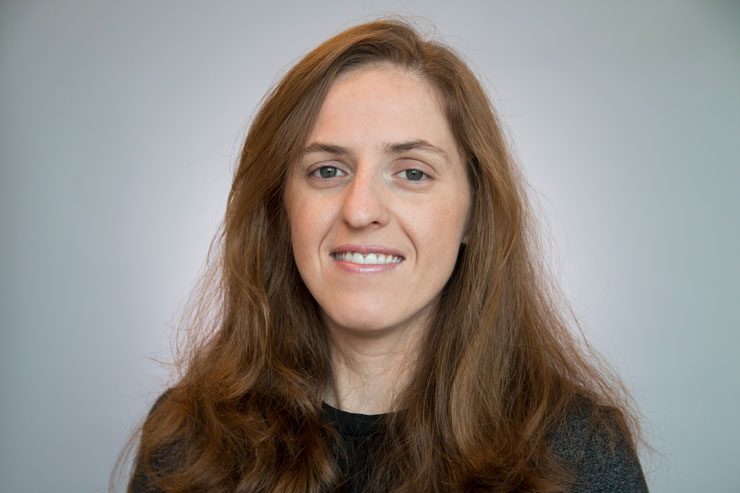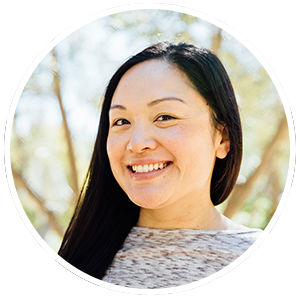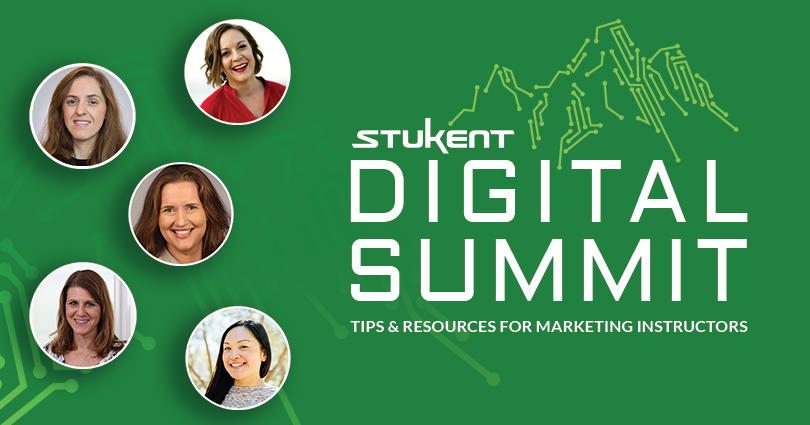A little after 1 a.m. on Saturday, March 7, Dr. Karen Sutherland took to the digital stage to share insights as a Spring 2020 Stukent Digital Summit (SDS) speaker. Her live remarks reached the Stukent offices in Idaho the day before, on Friday, March 6, just after 8 a.m.
The switch in days is accounted for in Karen speaking from Australia — an indication that educators are connected. Even by connections across time zones. And across an ocean.
How to Pair Students with Real Clients in Social Media Courses

Dr. Karen Sutherland, University of the Sunshine Coast
Karen’s remarks, which came in the first of five sessions for marketing instructors, centered on creating “win-win” partnerships pairing students with local business owners.
Her approach stems from Karen hearing that students needed more practical experience to land jobs and that local businesses could use social media support from students. The solution: “embedding more client work into the social media courses,” she said. “So that way students will get that practical experience to put on their CV … and we can also support the local business community.”
SEEING SUCCESS
Karen has seen success among her students at the University of the Sunshine Coast in Queensland and for businesses around the school’s area.
“You actually get to see students applying theory to practice, and they get real experience,” Karen said. “You actually get to help the local community as well, and the students enjoy that too.”
During the session, Karen presented four steps of this educational approach: preparation, promotion, registration, and communication. She also addressed client allocation and ways to overcome challenges that may arise with student-and-client collaborations. Karen said, “… the students aren’t working for free; they’re actually gaining credit towards their degree.”
ACCESS MORE
Additional resources and information: Watch Karen’s entire presentation, access her presentation slide deck and an article on the topic she presented, read her bio, and find links for connecting with Karen on socials.
You can also watch the entire presentation below.
How to Teach Writing for Digital Media: Brand Voice and Social Media

Elaine Venter, Colorado Mesa University
During her presentation, Elaine spoke of including “writing specifically” into an emerging media course description at Colorado Mesa University, pointing out that “because students have grown up so digital, they find this idea of social media posts almost automatically equals video or photo.”
KEY COMPONENTS
Elaine talked of key components of her emerging media course, including educating students on the importance of defining brand voice. Another is presenting to students the core English concepts of style, syntax, tone, and diction. Elaine also presented on assigning students a substantial amount of writing.
In the course, Elaine has students identify a brand, engage in social listening, and present how that brand’s voice is carried on multiple social media channels.
“It has been interesting for [students] to play with different creative writing styles by examining different brands,” she said.
Elaine’s students are assigned to write posts for different social media platforms — one that is quite open in terms of student creativity within guidelines and the other a structured post that would read true to a company’s brand. Students are also to write weekly blog posts for the course.
Elaine’s insights came with a backdrop from the social media manager at Sprout Social, Rachael Samuels, who, in writing of communication on socials, shares that “the core of communication always comes back to the written word.”
ACCESS MORE
Additional resources and information: Watch Elaine’s entire presentation, access her presentation slide deck, read her bio, and find a link for following Elaine on Twitter.
You can also watch the entire presentation below.
Unplugged: Using a Digital Detox to Teach Digital Marketing

Stacy Smollin Schwartz, Rutgers University
Stacy’s presentation focused on her digital detox assignments for undergraduate students. The three assignments create a five-week project that takes students through a usage audit, a two-day detox, and the sharing of what they learned.
The goals of the project fit into three overall categories: personal, professional, and societal.
ASSIGNMENT 1
The first assignment of the project, a digital usage audit, helps students who “were born omni-channel” recognize what qualifies as digital. Students are to estimate the number of minutes per day they use digital media, log their usage for a day, and then reflect on their identified results.
ASSIGNMENT 2
For the second assignment, “I tell [students] that they have 48 hours to refrain from extracurricular digital use,” she said. During that time, students are to log their experiences. This assignment also includes a reflection of the two-day detox. For the reflection aspect of the assignment, Stacy has her students identify when in the day they were prone to digital use and what they did instead of connecting digitally.
“Most students told me that day one was horrible, that it was awful, that they felt like they were mad at me … that they were feeling like they were missing everything, their friends were getting upset with them,” she said.
“The second day, though, they all said they woke up refreshed. They were like, ‘wow, I don’t have to check social media today. I don’t have to see what people are doing,’” Stacy said. “They actually felt like it was a weight off their shoulders.”
“Most students told me that day one was horrible, that it was awful, that they felt like they were mad at me … The second day, though, they all said they woke up refreshed.”
Stacy said that she wants students “as people and as marketers to know … that if you’re engaging … for a client, it’s your privileged time with that customer to engage with them on social media, so do it wisely, don’t waste it, don’t squander it.”
ASSIGNMENT 3
For the third assignment, students are to write detox experience articles and post them on LinkedIn. She said, “I have them share their detox story with the public, and I want them to do that with the audience of a future employer in mind.”
ACCESS MORE
Additional resources and information: Watch Stacy’s entire presentation, access her presentation slide deck, find links to digital detox assignments, and read Stacy’s bio.
You can also watch the entire presentation below.
How to Make Your Students Care: 5 Cs

Lydia Chen Shaw, California State Polytechnic University
“On the first day of class, I always tell my students what my accountability to them is,” Lydia said near the beginning of her presentation. “Beyond teaching, it’s really to get them in a forward path.”
Lydia gets them positioned for that path with an approach framed with five Cs.
CLARITY
In class, Lydia presents the first C, “Clarity,” via material from Geoff Colon and Aya Kikimova’s 2020 Microsoft Vision Report. The report shows “trends in marketing skills identified as important for the 2020s” based on responses to a LinkedIn poll of “600 global senior marketer participants.”
Students are presented with lists showing hard and soft skills that respondents identified in the poll. Lydia shares with students “this type of content or this type of asset to … get them moving and that extra push,” she said.
CONNECTION
“Connection,” the second C, is carried out by presenting students with job salary information posted on Glassdoor. The idea is to help students see what employment options may be available to them if they generate the marketing skills necessary for such jobs.
CONTEXT
In this phase, Lydia shares information on jobs for recent graduates and for workers years into their employment. To do so, she uses payscale.com, which, according to the company, “helps employers and their employees understand the right pay for every position and effectively communicate about compensation.”
CAPABLE
This C, “Capable,” is about students having the skills necessary for employment. Lydia conducts an activity related to email marketing skills in which “I will open my personal Gmail account … on the screen and I will show them the promotions tab,” she said. Lydia and her students then have a discussion that includes which emails stand out and why.
Lydia also uses a Snappos analysis project available in Stukent’s Digital Marketing Essentials textbook. She told the SDS audience that she found increased student preparation for the project after showing students an email marketing manager salary.
CONFIDENCE
The final C, “Confidence,” is about helping students see potential employment opportunities as they gain experience moving forward after graduation. She presents a chart that outlines possible progressive steps and gives students a LinkedIn assignment in which, she said, “I give them bite-sized, manageable chunks for improving their LinkedIn pages …”
ACCESS MORE
Additional resources and information: Watch Lydia’s entire presentation, access her presentation slide deck, find links to material referenced in the presentation, and read Lydia’s bio.
You can also watch the entire presentation below.
7 Creative Ways to Leverage Your Personal Brand to Create Opportunities

Karen Freberg, University of Louisville
Karen’s session aligns with her Summer 2019 SDS presentation in which she spoke of the importance of educators having personal brands. This time she talked of creating opportunities with those personal brands.
“… We have our websites, we have our blogs, we have our social media profiles, we do everything online, but now what?” she posed while framing her presentation.
She offered seven concepts for putting a personal brand to work:
1. Networking > Selling + Promoting
2. Aligning Passion Areas + Interests to Create Impact
3. Formulating Experiences
4. Becoming a Social Connector
5. Creating Social Proof + Evidence
6. Driving Content to Spark Impact
7. Zigging While Everyone Zags
On the first point, Karen said that educators “have to basically look at what we can do to network more effectively.” She recommended a soft-sell, authentic approach to connecting with others.
As for the second point, Karen called on educators to find groups whose interests align with their own or to create such groups if none exists.
Karen then expressed the idea to “utilize your personal brand to create experiences for students, for your colleagues, or even in the industry.”
On the topic of “becoming a social connector,” Karen said, “… you never know what type of opportunities you can gather by helping other people, by making these connections.”
For the fifth suggestion, Karen said, “You don’t want to tell people you have a personal brand, you want to show it.” She spoke of the importance of educators being able to present social proof of their personal brands.
Next, Karen addressed her six suggested ways to create opportunities with a personal brand. “Expertise needs to be communicated and shared in different formats and mediums to reach the max audience,” according to her presentation slide deck.
Consider what you have to offer as far as insights, expertise, and connections that could be of value to someone and present it in a unique way that is true to who you are.
In presenting the final point, “Zigging While Everyone Zags,” Karen said, “… what you want to do is stand out.” According to her slide deck presentation, “Consider what you have to offer as far as insights, expertise, and connections that could be of value to someone and present it in a unique way that is true to who you are.”
ACCESS MORE
Additional resources and information: Watch Karen’s entire presentation, access her presentation slide deck, and read her bio.
You can also watch the entire presentation below.
Virtual Conferences
This digital summit is the most recent virtual conference in an ongoing series. Click here to request access to the session recordings from this and previous SDS conferences.






